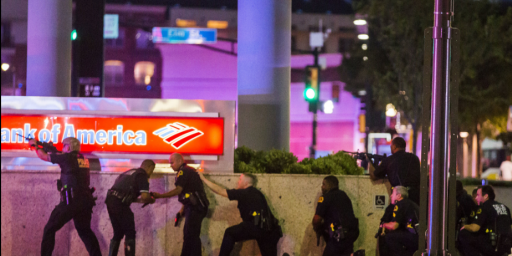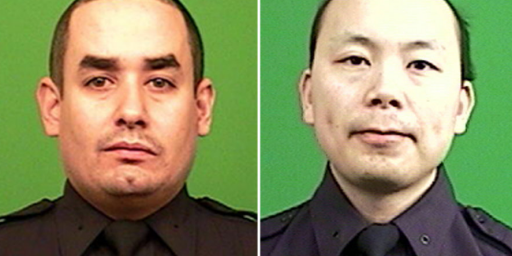On Resisting Arrest
Several of my recent posts have been on the question of whether a specific law can be said to be to blame for outcomes like the Eric Garner situation or whether it is about the enforcement of those laws (and the behavior of the police).
To add some numbers to that debate we have the following from Vox: 5% of New York cops turn in 40% of "resisting arrest" cases which suggests rather heavily that choices made by individual police officers matter. And, let me stress, the numbers suggest that the vast majority of police officers are not being overly aggressive with the civilians population.
If one clicks through to the piece there is an animated graphic that shows that 60% of officers make no resisting arrest charges while 5% account for 40% of such cases and 15% account for 72% of such arrests. (This is based on a study of 2009 of 51,000 cases—and is something that warrants wider study).
Obviously violence is more likely to occur when a suspect is resisting arrest. However, if a small slice of the force is very frequently encountering suspects who are resisting arrest this raise of the question of whether a given officer might not be creating unnecessary confrontations.
Note: I am not stating that suspects never resist arrest or that officers never have to use force to subdue suspects. I am noting, however, that the numbers here indicate that some police officers appear more prone to confrontation. While some of this may be explainable by specific assignments, the large number of cases would seem to suggest otherwise.
Quite honestly, this is just another example where we need more systematic data collection regarding these issues.






OK, here’s a question – given statistics like the ones you quote, and other observations like the fact that, despite its being outlawed, the NYPD clearly doesn’t care if its officer continue to you chokeholds on suspects, at what point can a court or a lawsuit come in to bust their chops for having a systemic abuse problem?
@legion:
I’m hoping Holder is working on just such a lawsuit.
This will help, especially if states and localities follow-or are made to follow-the federal example.
Unsurprisingly, these numbers are devoid of any context. Also, unsurprisingly Steven Taylor takes them at face value. Not all of the 35,000 NYPD officers actually execute arrests. Many work as supervisors or in some other capacity in which they don’t arrest people. Therefore, they won’t be filing charges of resisting arrest. If one cop works street patrol and arrests 100 people in a particular year and another cop works in the property room and arrests 0 people in a given year, it doesn’t mean that the first cop is a thug because he charges some people with resisting arrest. I would bet that a fairly small percentage of NYPD officers account for a fairly large percentage of all arrests in general. Therefore, it is understandable that a fairly small percentage of cops would file the majority of resisting arrest charges. Without controlling for that, these numbers don’t really tell us a whole lot.
As much as I’m right now upset about police conduct, statistics might not be the answer. How much are officers rotated between districts? I’m pretty sure there are a number of areas in NYC where you’d rarely have to deal with renitent arrestees, and others where you deal with it on a daily basis. Comparing the records of guys patrolling 1%ers in Staten Island and those working housing projects in the Bronx might be misleading.
@Gavrilo: If you click through and read the materials you will find that the percentage under discussion is of “arresting officers” not of all police officers in the system.
And, as I noted in the post: this is one year’s worth of observation and needs further study.
(Or, we could be snarky about a serious issue, which is much easier).
@Mu: And hence the call for more study. However, if truly 15% of all arresting officers account for 72% of all resisting arrest incidences and a full 60% of the arresting officers never make such claims something is going on beyond just assignments.
Those are stark numbers.
Is there a similar disparity in arrests in general? That is, if it turns out 60% of the officers in the NYPD don’t have duties that involve making arrests, then the fact they didn’t face any resistance doesn’t mean anything.
@Stormy Dragon: As I read the study it was of “arresting officers” and hence is a study of arrests.
@Steven L. Taylor:
I see that now. You may want to make your post more explicit; both it and the article you link to just refer to “officers” in general. You have to drill down three or four layers to find out it specifically only includes officers with at least one arrest.
@Steven L. Taylor:
Um, no. It’s 5% of the total officers on the NYPD force that file 40% of all resisting arrest charges. From the link:
Again, a significant percentage of NYPD officers probably make few if any arrests yet they are included in the total number of officers, thereby reducing the percentage of officers filing resisting arrest charges. In order for these numbers to have any real value, we would need to reduce the total from all police officers on the force to all police officers who have made arrests during the time period studied. But, if we did that, the percentage of cops filing resisting arrest charges would increase, probably significantly. That would hurt the narrative that Vox and others are trying to promote.
@Gavrilo:
“Just five percent of arresting officers during that period account for 40% of resisting arrest cases — and 15% account for more than half of such cases.”
(Indeed, it is Vox’s write up that causes the confusion).
Indeed, the study was of 51,503 cases of resisting arrest filed and of those cases filed and the percentages taken from there. It is about attributing arrests, not to all officers in the NYD.
One the one hand, I could have made that clear in the post, on the other this post is as much pointing to something else as anything else and it is not too much for me to assume that people click through and read before commenting in a strident fashion
@Steven L. Taylor:
That makes no sense. The chart includes that 60% of NYPD officers made no resisting arrest charges. How would they even know that if they only looked at officers who filed resisting arrest charges? The 60% has to be 60% of all NYPD officers. Therefore, the other percentages must be percentages of the total NYPD force.
@Gavrilo: You are correct–and in looking back I would still note that the study claims to be focused on “arresting officers” which suggests that the study is of arrests. But you are correct that my last comment was in error.
As I have repeatedly noted (starting with the initial post); more research is needed.
(The fact that this is a one year study alone means more data is needed).
@Gavrilo:
If you drill down all the way to the original WYNC version of the chart, the data source says:
@Stormy Dragon: Thanks–that settled that, then.
@Steven L. Taylor:
I didn’t see that disclaimer. I still don’t see it in the WNYC article. I’ll look again.
@Stormy Dragon:
Ok. Thank you for providing that.
On a separate note, could geography have something to do with the numbers. Are police walking the beat in certain neighborhoods more likely to encounter situations that lead to resisting arrest? And yes, I realize that this study is limited to NUC, but there are undoubtedly distinct neighborhoods throughout the city. I have no doubt there are police who are more prone to creating situations that lead to conflict, but I also wonder if the numbers may be skewed based on geography.
Eric Garner’s resistance is puzzling in that he apparently had never offered any resistance in his 30 prior arrests. And they weren’t distant events; at the time of his death he was out on bail for three recent arrests, one of which involved selling loosies. What we will never know is why he resisted for the first time,
This definitely sounds like an opportunity for more detailed study. Is there a difference between the way the officers are doing their job? Are there techniques that the small percentage of officers don’t use that they should? Or is it the population they deal with that lead to most of the difference?
It’s an interesting study and one that sets the stage for some possibly useful and enlightening information.